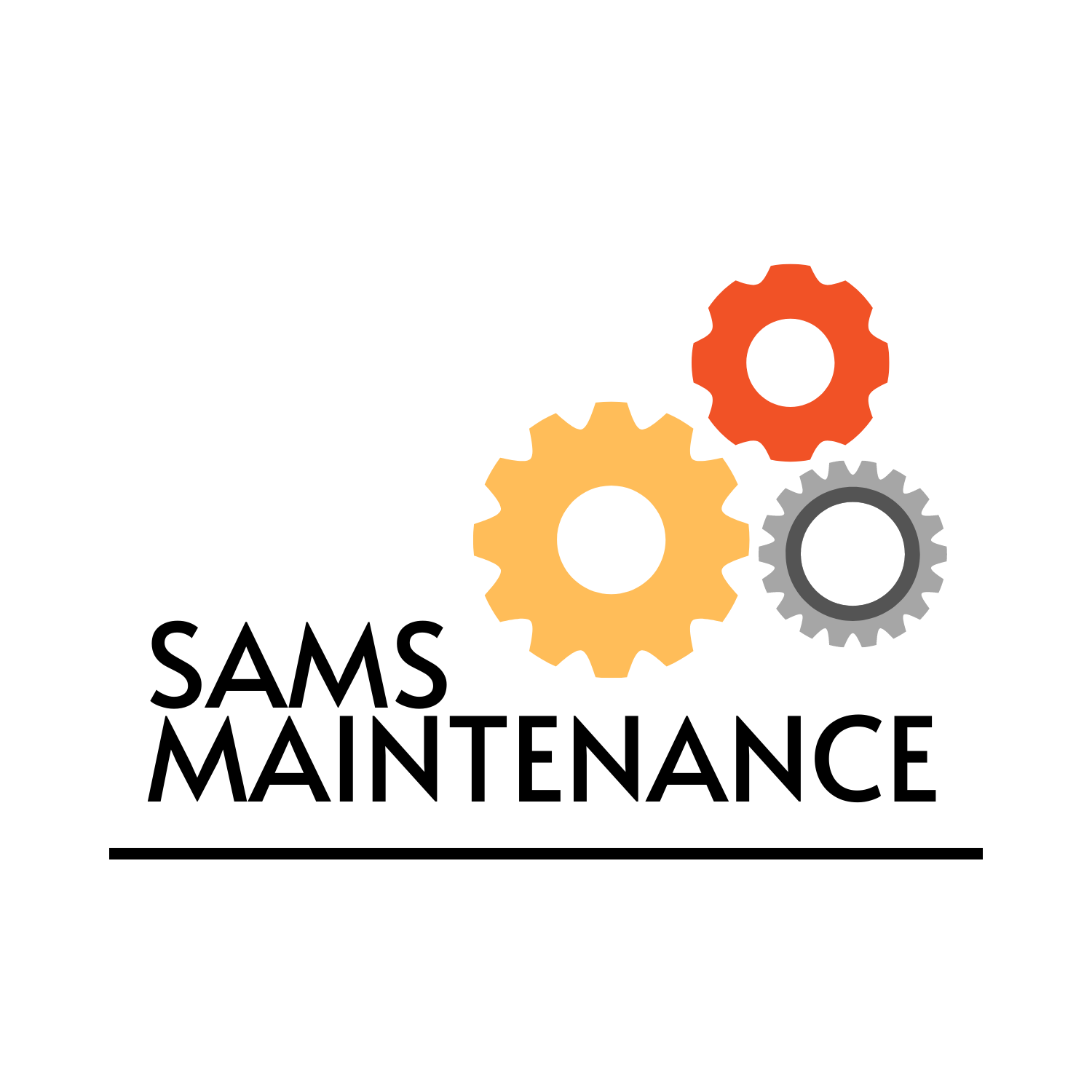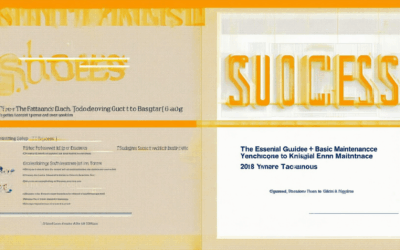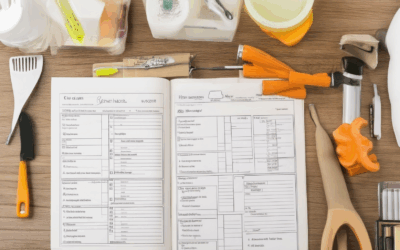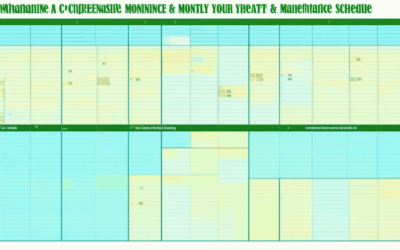Homeownership is a significant responsibility that requires constant care and attention. One of the most crucial aspects of maintaining your home is adopting a consistent monthly upkeep routine. This guide provides a comprehensive overview of essential monthly home upkeep practices, designed to help you stay on top of maintenance tasks, manage your budget effectively, and ensure your home remains in excellent shape year-round. Whether you’re a seasoned homeowner or new to the responsibilities, this guide offers actionable tips, checklists, and schedules tailored to fit your lifestyle. By following the advice within these pages, you can address potential issues before they escalate, save money on costly repairs, and extend the life of your home. Let’s dive into the details of creating a successful monthly home upkeep plan that works for you.
Key Takeaways
– Budget for Annual Upkeep: Set aside 1-4% of your home’s value annually for maintenance, such as 1% of a $200,000 home costing $2,000 yearly.
– Monthly Homeowner Expenses: Expect costs ranging from $1,000 for mortgages to $300 for utilities, plus property taxes, insurance, and maintenance.
– 1% Rule for Financial Prep: Save 1% of your home’s purchase price annually to cover unexpected repairs, like $3,000 for a $300,000 home.
– Manage Costs Effectively: Use a dedicated maintenance fund, consider home insurance, and invest in energy-efficient upgrades to minimize long-term expenses.

What is the Uphelp of a House?
The upkeep of a house refers to the routine maintenance and care required to preserve its condition, safety, and functionality. Proper upkeep ensures that minor issues are addressed before they escalate, preventing costly repairs and extending the lifespan of your home.
Here’s a breakdown of essential upkeep tasks:
Exterior Maintenance
- Roof Inspection : Check for missing shingles, cracks, or damage. Replace or repair as needed.
- Painting : Regularly repaint exterior surfaces to protect against weather damage and maintain curb appeal.
- Tree Pruning : Trim branches to prevent them from hanging over roofs or blocking gutters.
- Driveway and Walkway Maintenance : Clean and inspect for cracks or uneven surfaces. Repair as necessary.
Interior Maintenance
- Wall and Ceiling Inspections : Look for peeling paint, water stains, or signs of pests. Address issues promptly.
- Floor Care : Clean and inspect hardwood, tile, and carpet floors regularly. Address wear and tear.
- Window Cleaning : Remove dirt and grime to ensure proper insulation and energy efficiency.
- Pest Control : Schedule regular inspections for ants, spiders, and other pests. Treat as needed.
System Maintenance
- Heating, Ventilation, and Air Conditioning (HVAC) : Twice a year, clean or replace air filters, check ductwork for leaks, and ensure the system operates efficiently.
- Plumbing : Inspect pipes for leaks or corrosion. Fix minor issues before they become major problems.
- Electrical Systems : Test GFCI outlets, check for tripped breakers, and ensure wiring is secure.
- Appliances : Clean and maintain appliances like refrigerators, dishwashers, and ovens to prevent malfunctions.
Seasonal Tasks
- Spring/Fall Cleaning : Remove debris from gutters, clean out crawl spaces, and perform deep cleaning tasks.
- Winter Preparation : Insulate pipes, check for drafts, and remove hoses to prevent freezing.
Practical Tips
- Use a Maintenance Checklist : Create a personalized schedule to stay organized.
- Hire Professionals : For tasks requiring specialized skills, such as chimney cleaning or roof repairs.
By prioritizing these tasks, homeowners can ensure their houses remain in excellent shape, reducing the need for costly repairs and enhancing overall living comfort.
How Much Should You Budget for Home Maintenance?
Creating a monthly budget for home maintenance is essential for keeping your living space in great shape. Start by evaluating your primary monthly expenses, such as mortgage payments, utilities, property taxes, and homeowner’s insurance. According to the 10% rule, allocate 10% of these main expenses specifically for home maintenance.
For example, if your combined monthly expenses sum up to $3,000, setting aside 10% ($300) for home maintenance is a good starting point. This budget should cover routine tasks like lawn care, cleaning supplies, and minor repairs. However, this percentage may vary depending on factors like the size of your home, local costs, and the frequency of necessary repairs.
To enhance your preparedness, consider:
- Regular Savings:** Automate monthly contributions to build a reserve fund for unexpected repairs and improvements.
- Track Expenses:** Use budgeting tools or apps to monitor and manage your home maintenance spending effectively.
- Emergency Fund:** Set aside funds for unforeseen issues like appliance breakdowns or urgent repairs.
- Stay Informed:** Research local labor costs and market prices to better anticipate future expenses.
By following these guidelines, you can create a sustainable home maintenance budget tailored to your lifestyle and needs. Remember, consistency and preparation are key to maintaining your home’s health and longevity.

Regular Home Maintenance Checklist
Keeping your home in great shape requires consistent effort. Here’s a comprehensive list of regular home maintenance tasks to keep everything running smoothly:
- Plumbing System
- Clean and clear slow drains using a plunger or drain cleaner.
- Inspect for clogs caused by hair, soap buildup, or tree roots.
- Replace old pipes or install drain screens to prevent future clogs.
- HVAC System
- Change air filters monthly to maintain efficiency and indoor air quality.
- Check vents for adequate airflow and inspect ductwork for cleanliness and blockages.
- Schedule professional HVAC tune-ups twice a year to ensure optimal performance.
- Appliance Care
- Clean refrigerator coils and defrost the freezer regularly to prevent frost buildup.
- Run the dishwasher’s rinse cycle to prevent mold growth.
- Clean stove burners and check for gas leaks annually.
- Use the self-cleaning function on your oven monthly and clean the drip pans regularly.
- Electrical Systems
- Check for tripped circuit breakers and reset them as needed.
- Replace outdated outlets and switches with modern, safer options.
- Test GFCI outlets to ensure they’re functioning properly and protecting against electrical hazards.
- Water Heater Maintenance
- Drain the water heater tank every few months to remove sediment and extend its lifespan.
- Check the pressure relief valve to ensure it’s functioning correctly and adjust water pressure if necessary.
- Exterior Maintenance
- Inspect the roof for missing shingles or damage after severe weather events.
- Check chimneys for cracks or blockages, especially if you use them for heating.
- Gutter and downspout cleaning to prevent water pooling and foundation damage.
- Add gutter guards to reduce debris buildup and improve drainage.
- Landscape Maintenance
- Trim trees and bushes regularly to maintain their health and prevent branch drop.
- Prune dead or diseased branches to prevent pest infestations.
- Install and maintain proper sprinkler systems for consistent watering without overwatering.
- Fire Safety
- Test smoke detectors and carbon monoxide detectors monthly and replace batteries as needed.
- Check fire extinguishers to ensure they’re fully charged and functional.
- Create and practice an escape route map for your family in case of emergencies.
- Flooring and Carpets
- Clean grout lines and seal them regularly to prevent discoloration and dirt buildup.
- Vacuum carpets weekly to reduce dust and allergen accumulation.
- Check for loose tiles or uneven surfaces that could pose trip hazards.
- Windows and Doors
- Inspect weatherstripping for proper sealing and replace it if worn out.
- Lubricate hinges and locks to ensure smooth operation.
- Check window screens for tears or damage to maintain proper ventilation and security.
- Attics and Basements
- Inspect attics for leaks, moisture, or rodent activity and fix any issues promptly.
- Basement waterproofing to prevent moisture damage and mold growth.
- Organize storage areas for better accessibility and functionality.
- Security Systems
- Ensure all door locks are working properly and keys are securely stored.
- Monitor outdoor lighting to deter potential intruders.
- Consider installing a security camera system for added protection.
- Seasonal Tasks
- Clear gutters and downspouts before winter to prevent ice dams and water damage.
- Prepare the furnace for winter by cleaning it and checking venting.
- Fertilize lawns in spring and fall to promote healthy growth.
- Garage Door Maintenance
- Balance and test the garage door opener regularly to ensure smooth operation.
- Secure the garage door to prevent unauthorized access.

How Much Is the Annual Upkeep of a House?
A good rule of thumb for budgeting annual home maintenance is to set aside 1% to 4% of your home’s value. For instance, if your home is valued at $200,000, you should allocate between $2,000 and $8,000 each year for upkeep.
Breaking Down Maintenance Costs
- Lawn Care: $300-$800 annually, depending on the size and type of yard.
- General Repairs: $500-$1,500 for fixes like a leaky roof or furnace replacement.
- Utilities: $300-$600 for HVAC and plumbing maintenance.
- Exterior Maintenance: $400-$1,200 for painting and gutter cleaning.
- Regular Tasks: $300-$600 for mowing, landscaping, and minor renovations.
Additional Considerations
Your annual costs may vary based on:
- Your location due to climate and labor rates.
- The age of your home, as older properties may need more frequent repairs.
Managing Maintenance Expenses
- Create a dedicated maintenance fund to cover unexpected costs.
- Consider home insurance to protect against unforeseen damages.
- Invest in energy-efficient upgrades to reduce long-term expenses.
For more insights and DIY guides, explore our Home Maintenance Resources . Need professional assistance? Visit our trusted partners at Sam’s Maintenance Partners .
Monthly Costs of Owning a Home
Understanding the monthly costs of owning a home is essential for budgeting and financial planning. Here’s a breakdown of the key expenses homeowners typically encounter:
- Mortgage Payments : This is usually the largest expense. The amount varies based on loan type (fixed-rate, adjustable-rate), loan term, and interest rates. On average, homeowners spend between $1,000 to $3,000+ per month.
- Utilities : Includes electricity, water, heating, cooling, and trash services. Costs can range from $100 to $300+ depending on location and energy usage.
- Property Taxes : Typically assessed annually and paid quarterly. The average rate is around 1% of the home price, translating to approximately $200 to $600+ per month.
- Home Insurance : Protects against damage or destruction caused by fire, theft, or natural disasters. Premiums vary based on location, home age, and coverage level, averaging $50 to $200+ per month.
- Maintenance and Repairs : Routine upkeep like lawn care, plumbing, and appliance repair can cost between $100 to $500+ per month, depending on the home’s condition and size.
- HOA Fees (if applicable) : These are monthly dues for shared facilities like pools, gyms, or landscaping. Fees range from $0 to $300+ per month, depending on the community.
- Cable/Satellite TV : Optional but often included in monthly budgets. Prices vary from $20 to $150+ per month.
By tracking these expenses, homeowners can better manage their budgets and ensure financial stability. Regularly reviewing spending habits and exploring cost-saving measures can help minimize monthly costs while maintaining home maintenance.

What is the 1% Rule for Home Maintenance?
The 1% rule for home maintenance is a simple yet effective strategy to prepare financially for unexpected repair costs. Here’s a breakdown:
How the 1% Rule Works
Set aside 1% of your home’s purchase price annually for maintenance. This ensures you’re ready for unforeseen issues like appliance failures or structural problems.
Why It’s Important
Homeownership comes with ongoing costs. By following the 1% rule, you stay ahead of potential expenses and avoid financial stress when emergencies arise.
Example Calculation
For a $300,000 home:
- 1% of $300,000 = $3,000 annually
- $3,000 divided by 12 months = approximately $250 monthly
Additional Considerations
This rule is a guideline. Consider adding an emergency fund or separate savings account for major repairs like roofs or HVAC systems. Regular inspections and preventive maintenance can reduce the need for costly fixes.
Apply the Rule to Your Home
Whether you live in a newly built home or an older property, the 1% rule applies. Customize the percentage based on your personal circumstances and local market conditions.
Conclusion
Following the 1% rule is a smart move for long-term home care and financial stability. Stay prepared and enjoy peace of mind knowing your home is well-maintained.




0 Comments